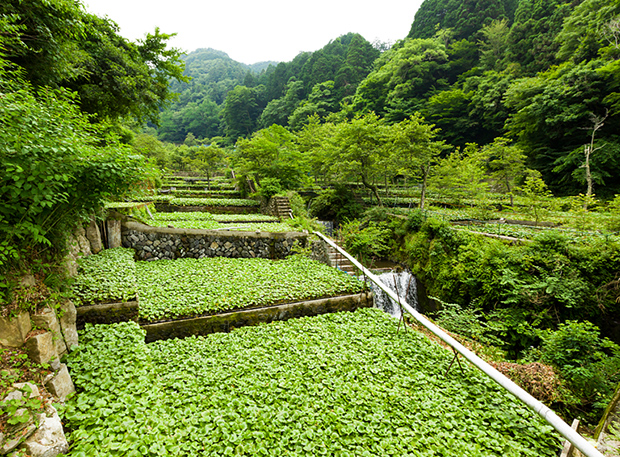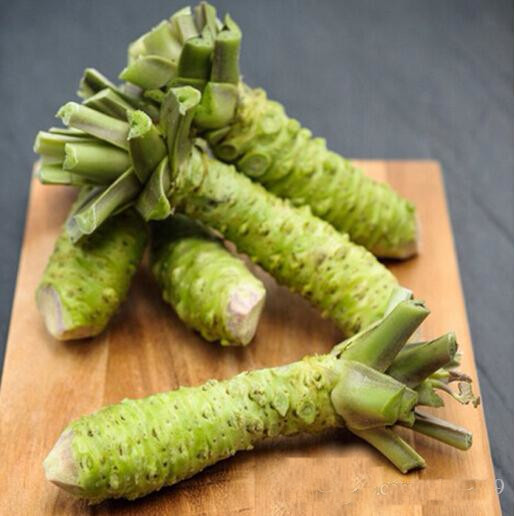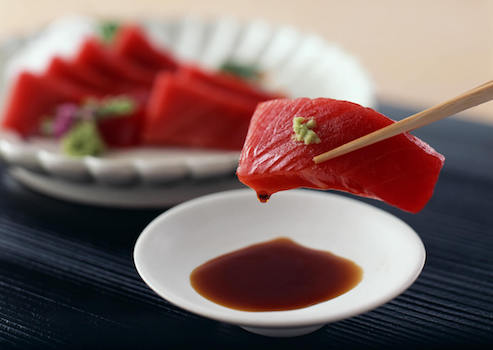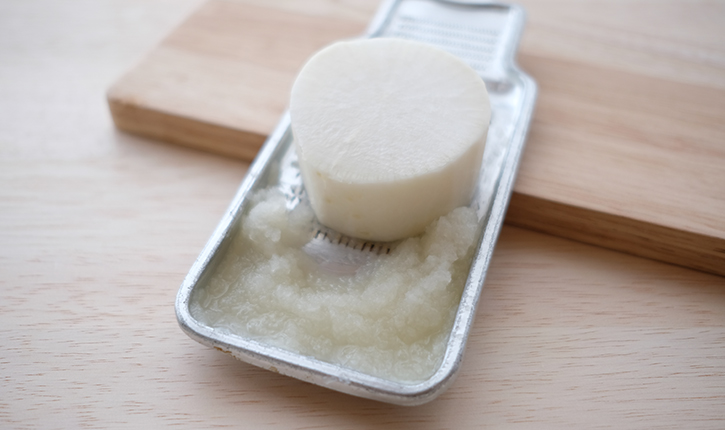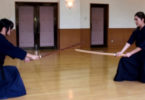You know “Sashimi (a slice of raw fish)”, “Wasabi” is absolutely necessary if you want really to experience ecstasy in your mouth and nose to go well with Sashimi dishes.
The term “Wasabi” has become an international word which we can find it in many well-noted English dictionaries.
And I translated “Wasabi” into “Japanese horseradish” in the title of this blog but there is a big difference among Wasabi, Horseradish and Japanese radish if we look into the matter in more details.
So I’d like to therefore talk about the difference and “Wasabi” for more understanding for you.
Contents
What’s Wasabi?
Our Japan, have fertile soil and clean water. Wasabi is a condiment unique to Japan that was created by the blessing of nature.
Grated wasabi has a pungent taste and a refreshing aroma. It complements dishes like sushi and soba. We can definitely say that Japanese cuisine is incomplete without it.
The Izu area in Shizuoka Prefecture has long been known as a center of wasabi production. It’s still cultivated in the traditional way here.
It grows naturally in mountainous areas, and it’s cultivated in the same kind of environment. The farmers make their way up mountain trails to get to their paddies.
It is grown in these terraced paddies that take advantage of the geographical characteristics of the valley.
It is a very delicate plant. Valleys are ideal for its cultivation because temperature variations throughout the year are small and the amount of sunshine they receive is just right.
Water is the most important element of wasabi cultivation, and a great deal of water is needed because it absorbs nutrients from it.
The terraced paddies were created by piling up rocks and stones of various sizes. By acting as a filter, they keep the water clean at all times.
The farmers constantly have to clear away fallen branches and unwanted rocks in order to maintain a strong flow of water.
And they have no choice but to do everything manually because the paddies are located deep in the mountains.
It’s thanks to the natural conditions and the farmers’ hard work that good taste can be grown and harvested.
It became an everyday feature of Japan’s food culture in the mid-19th century, and the catalyst for that was an exceptionally good catch of tuna.
Supply far outstripped demand. However, somebody came up with a good idea for using all the excess tuna meat and promoting its consumption by soaking it in soy sauce.
With the addition of wasabi, it smelled and tasted so good that it became a huge hit. And that’s how wasabi became an essential condiment in a country that loves raw fish.
What difference among “Wasabi”, “Horseradish” and “Japanese radish”?
Wasabi is often compared with horseradish as they are both plants and we usually taste grated roots.
Big difference between Wasabi and Horseradish is Wasabi has a very pungent flavour, even just a small amount, but horseradish is not quite so powerful.
I’m not so familiar with horseradish now that it’s a European plant of the cabbage family, grown for its pungent edible root, which is said to be the one of the best garnish for roast beef.
And it is shorter and greenish, while horseradish is longer and yellowish.
Regarding Japanese radish, we say “Daikon”, it’s a swollen pungent-tasting edible root.
Radish is used as a variety of ingredients. For miso soup, salad, and the best as grated radish.
When it comes to grilled fish, especially pacific saury, it is the best garnish.
In conclusion, Wasabi highlights the original taste of ingredients. It’s a key supporting player in Japan’s culinary culture.
Writing about today’s topic, I feel like mouth-watering, having a transcendent deliciousness in Sashimi with Wasabi at dinner!
How about you on this matter? I’d like to recommend to visit the blog of “Maguro (Tuna) for Sashimi” to be well worth, thanks
You know “Sashimi (a slice of raw fish)”, “Wasabi” is absolutely necessary if you want really to experience ecstasy in your mouth and nose to go well with Sashimi dishes.
The term “Wasabi” has become an international word which we can find it in many well-noted English dictionaries.
And I translated “Wasabi” into “Japanese horseradish” in the title of this blog but there is a big difference among Wasabi, Horseradish and Japanese radish if we look into the matter in more details.
So I’d like to therefore talk about the difference and “Wasabi” for more understanding for you.
What’s Wasabi?
Our Japan, have fertile soil and clean water. Wasabi is a condiment unique to Japan that was created by the blessing of nature.
Grated wasabi has a pungent taste and a refreshing aroma. It complements dishes like sushi and soba. We can definitely say that Japanese cuisine is incomplete without it.
The Izu area in Shizuoka Prefecture has long been known as a center of wasabi production. It’s still cultivated in the traditional way here.
It grows naturally in mountainous areas, and it’s cultivated in the same kind of environment. The farmers make their way up mountain trails to get to their paddies.
It is grown in these terraced paddies that take advantage of the geographical characteristics of the valley.
It is a very delicate plant. Valleys are ideal for its cultivation because temperature variations throughout the year are small and the amount of sunshine they receive is just right.
Water is the most important element of wasabi cultivation, and a great deal of water is needed because it absorbs nutrients from it.
The terraced paddies were created by piling up rocks and stones of various sizes. By acting as a filter, they keep the water clean at all times.
The farmers constantly have to clear away fallen branches and unwanted rocks in order to maintain a strong flow of water.
And they have no choice but to do everything manually because the paddies are located deep in the mountains.
It’s thanks to the natural conditions and the farmers’ hard work that good taste can be grown and harvested.
It became an everyday feature of Japan’s food culture in the mid-19th century, and the catalyst for that was an exceptionally good catch of tuna.
Supply far outstripped demand. However, somebody came up with a good idea for using all the excess tuna meat and promoting its consumption by soaking it in soy sauce.
With the addition of wasabi, it smelled and tasted so good that it became a huge hit. And that’s how wasabi became an essential condiment in a country that loves raw fish.
What difference among “Wasabi”, “Horseradish” and “Japanese radish”?
Wasabi is often compared with horseradish as they are both plants and we usually taste grated roots.
Big difference between Wasabi and Horseradish is Wasabi has a very pungent flavour, even just a small amount, but horseradish is not quite so powerful.
I’m not so familiar with horseradish now that it’s a European plant of the cabbage family, grown for its pungent edible root, which is said to be the one of the best garnish for roast beef.
And it is shorter and greenish, while horseradish is longer and yellowish.
Regarding Japanese radish, we say “Daikon”, it’s a swollen pungent-tasting edible root.
Radish is used as a variety of ingredients. For miso soup, salad, and the best as grated radish.
When it comes to grilled fish, especially pacific saury, it is the best garnish.
In conclusion, Wasabi highlights the original taste of ingredients. It’s a key supporting player in Japan’s culinary culture.
Writing about today’s topic, I feel like mouth-watering, having a transcendent deliciousness in Sashimi with Wasabi at dinner!
How about you on this matter? I’d like to recommend to visit the blog of “Maguro (Tuna) for Sashimi” to be well worth, thanks












